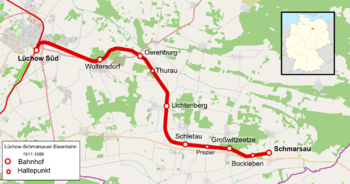Lüchow-Schmarsauer Railway
| LSE Lüchow-Schmarsauer Railway | |||||||||||||||||||||||||||||||||||||||||||||||||||||
|---|---|---|---|---|---|---|---|---|---|---|---|---|---|---|---|---|---|---|---|---|---|---|---|---|---|---|---|---|---|---|---|---|---|---|---|---|---|---|---|---|---|---|---|---|---|---|---|---|---|---|---|---|---|
| Route number : | 9114 | ||||||||||||||||||||||||||||||||||||||||||||||||||||
| Course book section (DB) : | 109k (1953-1969) | ||||||||||||||||||||||||||||||||||||||||||||||||||||
| Route length: | 17.2 km | ||||||||||||||||||||||||||||||||||||||||||||||||||||
| Gauge : | 1435 mm ( standard gauge ) | ||||||||||||||||||||||||||||||||||||||||||||||||||||
|
|||||||||||||||||||||||||||||||||||||||||||||||||||||
The Lüchow- Schmarsauer Eisenbahn GmbH (LSE) is a Lower Saxon society that from 1911 to 1998 the railway line from Lüchow by Schmarsau operation and is still working as a bus company with the line number 8050 today.
history
The company was founded on April 16, 1910 as Kleinbahn Lüchow – Schmarsau GmbH . The main shareholders were the Prussian state, the province of Hanover , whose shares were transferred to the state of Lower Saxony in 1945, and the former Lüchow district . The Lüchow-Dannenberg district is currently the sole shareholder.
It opened its standard-gauge line on December 15, 1911, which ran from Lüchow Süd station - near the state station on the Salzwedel – Dannenberg railway line - in a south-easterly direction through the Lemgow region in the south of the Wendland between the Elbe and Jeetzel to the end point in the town of Schmarsau . It was 17 kilometers long. An originally planned extension via Schrampe to Arendsee (Altmark) was not implemented.
From April 1, 1932, operational management was in the hands of the State Small Railway Authority in Hanover, which later became the Lower Saxony State Railway Authority . After its closure, the Osthannoversche Eisenbahnen AG (OHE) ran from October 1, 1959 to April 1, 1969 , and since then the district administration has been in charge of the remaining traffic.
In 1914 63,472 people and 19,667 tons of goods were transported. Freight traffic had its focus on the removal of sugar beet and potatoes in autumn and the transport of pigs, cattle and horses. In addition, in the early 1920s the Lüchow – Schmarsauer Eisenbahn transported 35 loads of lawn iron ore every day , which was mined near Simander. However, the mining of this inferior ore was stopped again when the smelting works in the Ruhr area were able to obtain raw materials from abroad again. The Count of Bernstoff also benefited from the railway, as he was able to bring about 1000–1500 solid cubic meters of wood from the Gartower Forest to the Lüchower station every year . Loading stations were in Großwitzeetze and Oerenburg.
In 1918, a narrow-gauge siding from Oerenburg to Schnackenburg was planned. The rails to be supplied from army stocks were to be laid between Trebel and Gartow parallel to today's B 493 on the sandy road on the side. The project was abandoned because of the risk of forest fire and economic considerations in favor of a privately operated forest railway along the Wirler Chaussee .
The reorientation of traffic flows through the inner German border after 1945 , which cut off the previous connections to the east, initially brought about an upswing in passenger traffic, but this remained unprofitable due to the high proportion of school traffic. The traffic was never very important, a daily pair of freight trains and three to four pairs of passenger trains were the norm. Since November 10, 1952, a railroad's own bus service has supplemented passenger transport, which is still operated today (2016).
Although the Deutsche Bundesbahn no longer operated the Lüchow station by rail from 1960 to 1965, the LSE did not abandon passenger traffic until March 31, 1969, at the same time freight traffic was limited to serving the sidings in Lüchow until freight traffic the Deutsche Bahn between Dannenberg (Elbe) and Lüchow on June 30, 1998 was discontinued.
Investments
There were massive reception buildings in Lüchow and Schmarsau, and smaller ones in Oerenburg and Woltersdorf. There was also a locomotive shed in Schmarsau. The Lüchow Süd station building was demolished in April 2003 in order to build a parking lot for a hardware store there. Until October 6, 2006, the LSE maintained a transfer track to the current rail network of the Deutsche Regionaleisenbahn GmbH (DRE) . Since then, the LSE has been a pure bus company.
vehicles
The traffic was initially handled with two steam locomotives , which were taken out of service in 1961/1962. In 1933 the first railcar , a Wismar rail bus , was procured. A second, four-axle railcar (road number T 156) with an eventful past was added used in 1954. In 1961 the first diesel locomotive , a V 20 , was also bought second-hand. From 1975 there was only one road- rail vehicle that was used until 1996. The Wismar rail bus is preserved in the Darmstadt-Kranichstein Railway Museum. The T 156 railcar was scrapped in 1970, the diesel locomotive was sold to Italy in 1975.
A three-axle LSE baggage car with the number 1252 has been preserved at the Association of Traffic Amateurs and Museum Railways in Schönberger Strand .
literature
- Gerd Wolff: German small and private railways. Volume 10: Lower Saxony 2. Between Weser and Elbe. EK-Verlag, Freiburg 2007, pp. 433-450, ISBN 978-3-88255-669-8
Web links
Individual evidence
- ↑ a b Burghard Kullow: Back then in Wendland . edition limosa, Clenze 2008, ISBN 3860373455 , p. 92/93: High activity at the train stations.
- ↑ a b Otto Puffahrt: contributions to the history of the old ministry Gartow. Gartow 1990, p. 104: Railway projects.
- ↑ Bahn Extra 3/2018: branch lines in the 1960s , p. 7

